Our official English website, www.x-mol.net, welcomes your feedback! (Note: you will need to create a separate account there.)
Probing Molecular Behavior of Carbonyl Groups at Buried Nylon/Polyolefin Interfaces in Situ.
Langmuir ( IF 3.9 ) Pub Date : 2020-09-01 , DOI: 10.1021/acs.langmuir.0c02188 Bolin Li 1 , John S Andre 1 , Xiaoyun Chen 2 , Brian Walther 3 , Rajesh Paradkar 3 , Chuang Feng 1 , Christopher Tucker 2 , Carol Mohler 2 , Zhan Chen 1
Langmuir ( IF 3.9 ) Pub Date : 2020-09-01 , DOI: 10.1021/acs.langmuir.0c02188 Bolin Li 1 , John S Andre 1 , Xiaoyun Chen 2 , Brian Walther 3 , Rajesh Paradkar 3 , Chuang Feng 1 , Christopher Tucker 2 , Carol Mohler 2 , Zhan Chen 1
Affiliation

|
Nylon and maleic anhydride (MAH)-grafted polyolefin-based thin co-extruded multilayer films are widely used in packaging applications encountered in daily life. The molecular structure of the nylon/MAH-grafted polyolefin buried interface and molecular bonding between these two chemically dissimilar layers are thought to play an important role in achieving packaging structures with good adhesion. Here, the molecular bonds present at a nylon/maleic anhydride (MAH)-grafted polyethylene buried interface were systematically examined in situ for the first time using sum frequency generation (SFG) vibrational spectroscopy. The carbonyl stretching frequency region of the SFG spectra of a nylon/MAH-grafted polyethylene buried interface showed the presence of hydrolyzed MAH groups grafted to the polyethylene chain and very low levels of unreacted MAH enriched at the buried interface. The ability of SFG to detect these molecular species at the buried interface yields important understanding of the interfacial molecular structure and provides the basis for subsequent in situ studies of the bonding reaction between the grafted MAH and nylon directly at the interface. This understanding may guide the design of multilayer films with improved properties such as enhanced adhesion between polymer layers. The approach used in this study is general and is applicable to study the molecular characteristics of other buried interfaces of significance, such as buried interfaces involving polymers in solar cells, polymer semiconductors, and batteries. Nylon impact modification is another area of interest where the interaction between the MAH-grafted elastomer and the continuous phase of nylon is important.
中文翻译:

在埋入的尼龙/聚烯烃界面上探究羰基的分子行为。
尼龙和马来酸酐(MAH)接枝的聚烯烃基薄共挤多层薄膜广泛用于日常生活中的包装应用中。尼龙/ MAH接枝的聚烯烃掩埋界面的分子结构以及这两个化学不同层之间的分子键被认为在获得具有良好粘合性的包装结构中起着重要作用。在这里,首次使用总频率生成(SFG)振动光谱系统地系统地检查了存在于尼龙/马来酸酐(MAH)接枝的聚乙烯掩埋界面上的分子键。尼龙/ MAH接枝的聚乙烯掩埋界面的SFG光谱的羰基拉伸频率区域显示存在接枝到聚乙烯链上的水解MAH基团,并且在掩埋界面富集的未反应MAH的水平非常低。SFG在掩埋界面处检测这些分子种类的能力使人们对界面分子结构有了重要了解,并为随后就接枝MAH和尼龙直接在界面处的键合反应进行后续原位研究提供了基础。该理解可以指导具有改善的性质例如增强的聚合物层之间的粘附性的多层膜的设计。本研究中使用的方法是通用方法,适用于研究其他重要的埋藏界面的分子特征,例如涉及太阳能电池,聚合物半导体和电池中聚合物的掩埋界面。尼龙抗冲改性是另一个有趣的领域,在该领域中,MAH接枝的弹性体与尼龙的连续相之间的相互作用很重要。
更新日期:2020-09-29
中文翻译:

在埋入的尼龙/聚烯烃界面上探究羰基的分子行为。
尼龙和马来酸酐(MAH)接枝的聚烯烃基薄共挤多层薄膜广泛用于日常生活中的包装应用中。尼龙/ MAH接枝的聚烯烃掩埋界面的分子结构以及这两个化学不同层之间的分子键被认为在获得具有良好粘合性的包装结构中起着重要作用。在这里,首次使用总频率生成(SFG)振动光谱系统地系统地检查了存在于尼龙/马来酸酐(MAH)接枝的聚乙烯掩埋界面上的分子键。尼龙/ MAH接枝的聚乙烯掩埋界面的SFG光谱的羰基拉伸频率区域显示存在接枝到聚乙烯链上的水解MAH基团,并且在掩埋界面富集的未反应MAH的水平非常低。SFG在掩埋界面处检测这些分子种类的能力使人们对界面分子结构有了重要了解,并为随后就接枝MAH和尼龙直接在界面处的键合反应进行后续原位研究提供了基础。该理解可以指导具有改善的性质例如增强的聚合物层之间的粘附性的多层膜的设计。本研究中使用的方法是通用方法,适用于研究其他重要的埋藏界面的分子特征,例如涉及太阳能电池,聚合物半导体和电池中聚合物的掩埋界面。尼龙抗冲改性是另一个有趣的领域,在该领域中,MAH接枝的弹性体与尼龙的连续相之间的相互作用很重要。

























 京公网安备 11010802027423号
京公网安备 11010802027423号